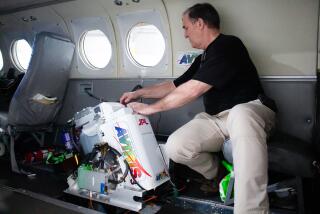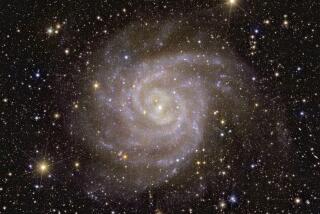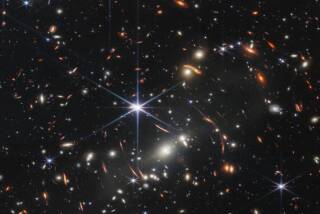Dark Energy Camera, new mega-eye on the sky, probes ancient mystery
- Share via
The first images are in from the Dark Energy Camera. A week ago, astronomers and researchers from around the world began a collaborative experiment using the super-powerful camera to create a massive three-dimensional map that delves deep into the universe.
The camera at the center of the Dark Energy Survey astronomical experiment in Chile is cataloging the sky, bit by bit over 525 nights. “It will record information on over 300 million galaxies, most so faint that their light is around 1 million times fainter than the dimmest star that can be seen with the naked eye,” according to the survey’s website.
Galaxies up to 8 billion light-years away will be captured by the so-called DECam, according to the U.S. Department of Energy’s Lawrence Berkeley National Laboratory. The camera can “reach wide and deep into the night sky,” the lab said, thanks to components such as 62 charge-coupled devices invented at the lab.
PHOTOS: Awesome images from space
The camera -- a very sensitive 570-megapixel device -- is high in the Chilean Andes, but U.S. institutions have provided essential pieces for this unprecedented effort, including the “world’s largest filter changer” from the University of Michigan and a “one-of-a-kind cryogenics system to keep photo chips at minus 100 degrees Celsius,” from Fermilab in Chicago.
Each night, the state-of-the-art camera takes 400 images, says the Dark Energy Survey website, each one of those a gigabyte in size.
DECam is the largest digital camera ever built, according to the Energy Department’s website, and includes mirrors measuring 3 feet across. It weighs about 5 tons.
SPACE QUIZ: Blue moons and more
The whopper-size photos this huge camera takes are sent to the National Center for Supercomputer Applications in Illinois to be reduced and stored. That facility creates “combined images,” the survey site says, before the galaxies and stars that they reveal are identified, cataloged, measured and stored in a database.
The survey says 120 scientists from 23 organizations banded together for this research, which could provide insight into the multibillion-year history of cosmic expansion -- to help begin to answer the question “why is the universe speeding up?” -- and the nature of dark matter.
As the Los Angeles Times’ Science Now blog reported last week, a new study shows that dark energy, “the mysterious and poorly understood force that scientists have proposed is somehow causing the universe to expand at an accelerating rate,” is likely real. How likely? 99.996% likely.
“Nevertheless, dark energy, like dark matter, remains that most enigmatic of physical entities: Something we can detect but not understand,” wrote The Times’ Jon Bardin.
Perhaps the Dark Energy Camera can help shed a little light on this dark force.
[For the record, 10:51 a.m.: An earlier version of this post reported that Fermilab’s cryogenics system kept photo chips at 100 degrees Celsius, which, astute readers pointed out, is the boiling point of water. The correct temperature is minus-100 degrees Celsius -- very cold as opposed to very hot. Thanks to readers for pointing out the error.]
ALSO:
Endeavour will do flyovers on its way to L.A.
Human sperm have four different swimming strokes
A toothbrush fix and a new record is set at the International Space Station
Join Amy on Google+. Email: [email protected]
More to Read
Sign up for Essential California
The most important California stories and recommendations in your inbox every morning.
You may occasionally receive promotional content from the Los Angeles Times.











